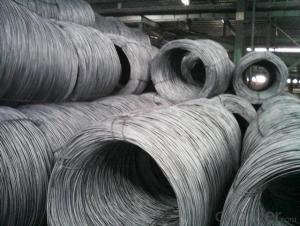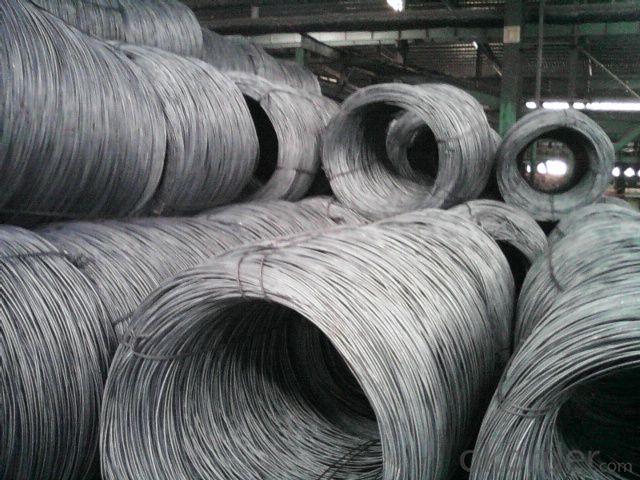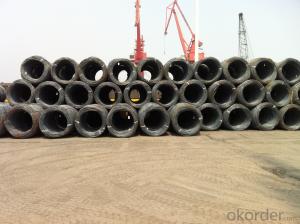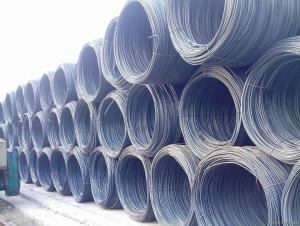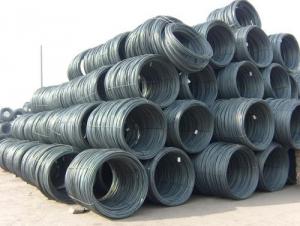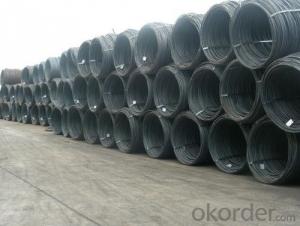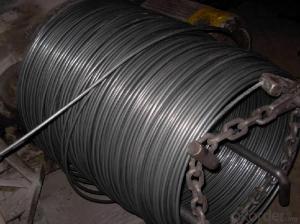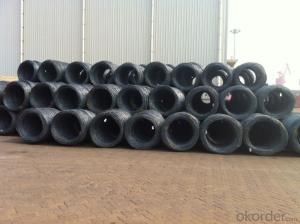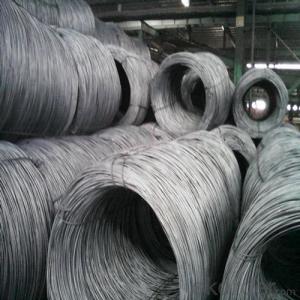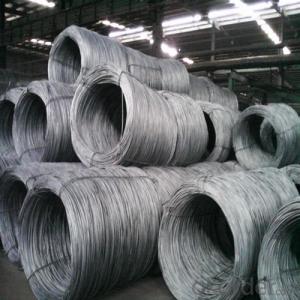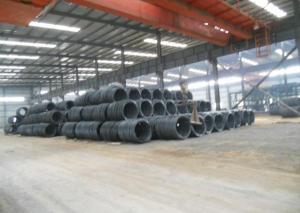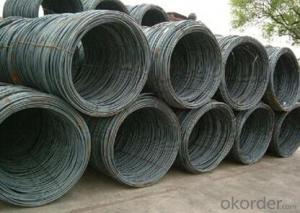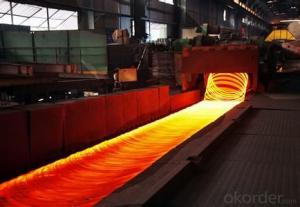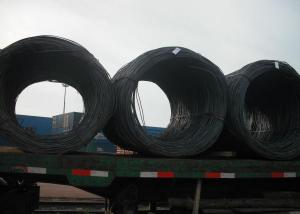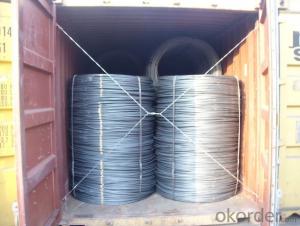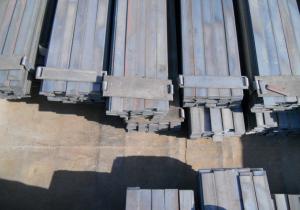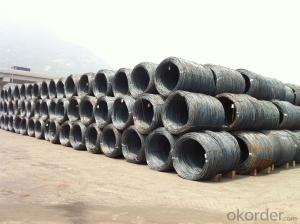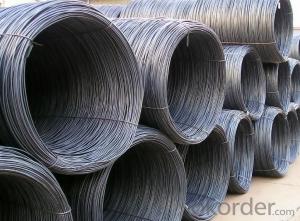Q235 Steel Wire Rod
- Loading Port:
- China Main Port
- Payment Terms:
- TT OR LC
- Min Order Qty:
- -
- Supply Capability:
- -
OKorder Service Pledge
OKorder Financial Service
You Might Also Like
Specifications of Wire Rod Q235:
Grade: Q235 Standard: GB
Diameter: 5.5mm, 6.5mm, 7mm, 8mm, 9mm, 10mm, 11mm, 12mm
Alloy or Not: Alloy
Technique: Hot Rolled Place of Origin: China Mainland
Chemical Composition:
Please kindly find our chemistry of our material based on Q235 as below for your reference:
Trademark | Rank | Chemical composition (quality score) % | | ||||
C | Si | Mn | S | P | | ||
| | |||||||
| ≤ |
| ≤ | ≤ | | ||
Q235 | A | 0.14-0.22 | 0.30 | 0.30-0.65 | 0.050 | 0.045 | |
Q235 | B | 0.12-0.20 | 0.30 | 0.30-0.70 | 0.045 | 0.045 | |
Trademark | Rank | Pulling Test | | ||||
Bend PointΔs/Mpa | Tensile Strength | Elongation Ratioδ5% | | ||||
| | |||||||
Thickness (Diameter) /MM | Thickness (Diameter) /MM | | |||||
≤16 | 16-40 | | ≤16 | 16-40 | | ||
≥ | | ≥ | | ||||
Q235 | A | 235 | 225 | 375-500 | 26 | 25 | |
Q235 | B | 235 | 225 | 375-500 | 26 | 25 | |
Usage and Applications of Wire Rod Q235:
After hot-rolled the products shaped into coil and delivery as finished product, including round, square,rectangular, hexagonal and so on. Since most of the products are round, it is generally called wire rod. Carbon steel wire rod is widely used in construction and manufacturing. Carbon steel wire rod is mainly used for reinforcement of reinforced concrete and welded structure or reprocessed (roberts , nail, etc.) materials, especially used to produce wire drawing, welding electrode, nails, spring, electronic, precise machinery parts and so on.
Packaging & Delivery of Wire Rod Q235:
Packaging Detail: products are packed in coil and then shipped by container or bulk vessel
Each coil weight: About 2.05MT
Delivery Detail: within 45 days after received deposit or LC.
Label: to be specified by customer, generally, each bundle has 1-2 labels
Trade terms: FOB, CFR, CIF
*If you would like to get our price, please inform us the size, standard/material and quantity. Thank you very much for your attention.
- Q: How is the steel wire rod market affected by changes in trade policies?
- Changes in trade policies can have a significant impact on the steel wire rod market. Trade policies, such as tariffs or import/export restrictions, can affect the supply and demand dynamics of steel wire rods. If a country imposes tariffs on imported steel wire rods, it can lead to a decrease in imports and an increase in domestic production. This can result in higher prices for steel wire rods within the domestic market. Conversely, if trade policies are liberalized, allowing for easier import and export of steel wire rods, it can increase competition and potentially lower prices. Therefore, changes in trade policies can influence the competitiveness and profitability of companies in the steel wire rod market.
- Q: What are the different storage methods for steel wire rod?
- There are several different storage methods for steel wire rod, including coil storage, bundle storage, and pallet storage. Coil storage involves stacking the wire rod coils on top of one another, either vertically or horizontally. Bundle storage involves tying multiple wire rod bars together in a bundle and storing them on racks or shelves. Pallet storage involves placing the wire rod coils or bundles on pallets and storing them in a warehouse or storage facility. Each method has its own advantages and is chosen based on factors such as space availability, ease of access, and transportation requirements.
- Q: What are the typical chemical compositions of steel wire rod?
- The typical chemical compositions of steel wire rods can vary depending on the specific grade and intended use of the wire rod. However, the most common elements found in steel wire rods are iron (Fe) and carbon (C). The percentage of carbon in steel wire rods usually ranges from 0.05% to 0.85%. In addition to iron and carbon, other elements are often added to steel wire rods to enhance specific properties. These elements include manganese (Mn), silicon (Si), sulfur (S), phosphorus (P), and sometimes chromium (Cr), nickel (Ni), and copper (Cu). Manganese is commonly added to improve the strength and hardenability of the wire rod. Silicon is added to enhance the steel's resistance to oxidation and improve its electrical properties. Sulfur and phosphorus are impurities that are usually restricted to low levels as they can negatively affect the steel's ductility and toughness. Chromium, nickel, and copper are sometimes added to steel wire rods to improve their resistance to corrosion or to enhance specific mechanical properties. These elements are commonly found in stainless steel wire rods, which are used in applications requiring high corrosion resistance. It is important to note that the exact chemical composition of steel wire rods may vary depending on the specific steelmaking process and any additional alloying elements or impurities present. Therefore, it is crucial to refer to the specifications or standards provided by the manufacturer to determine the precise chemical composition of a particular steel wire rod.
- Q: What are the recent developments and innovations in steel wire rod production?
- Recent developments and innovations in steel wire rod production include the use of advanced technologies such as continuous casting and direct hot charging, which result in higher quality and more efficient production processes. Additionally, the implementation of automation and digitalization in steel wire rod mills has led to improved productivity and reduced energy consumption. Furthermore, there have been advancements in the alloying and heat treatment techniques used to enhance the mechanical properties and performance of steel wire rods.
- Q: What are the different types of corrosion resistance tests conducted on steel wire rod?
- There are several different types of corrosion resistance tests that are commonly conducted on steel wire rods. These tests aim to determine the ability of the wire rod to resist corrosion in various environments. Some of the commonly used corrosion resistance tests for steel wire rods include: 1. Salt Spray Test: This test involves subjecting the wire rod to a continuous salt spray environment. The rod is placed in a chamber where it is exposed to a saline solution mist. The test measures the time it takes for the wire rod to show signs of corrosion, such as rust formation. 2. Humidity Test: In this test, the wire rod is subjected to a high humidity environment for a specific period of time. The humidity level is controlled, and the wire rod is evaluated for any signs of corrosion, such as oxidation or surface discoloration. 3. Cyclic Corrosion Test: This test involves subjecting the wire rod to repeated cycles of different corrosive environments, such as salt spray, humidity, and dry heat. The rod is exposed to these conditions in a controlled manner, and its resistance to corrosion is assessed based on the appearance and extent of corrosion after each cycle. 4. Electrochemical Corrosion Test: This test measures the corrosion potential and corrosion current of the wire rod using electrochemical techniques. The wire rod is immersed in a corrosive solution, and its response to an applied electrical potential is evaluated. This test provides insights into the corrosion behavior and performance of the wire rod. 5. Acid Resistance Test: This test evaluates the wire rod's resistance to acid corrosion. The rod is immersed in an acidic solution for a specified period of time, and its weight loss or surface appearance is measured to assess the extent of corrosion. 6. Pitting Corrosion Test: Pitting corrosion is a localized form of corrosion that can be particularly damaging. This test involves exposing the wire rod to a corrosive environment where pitting corrosion is likely to occur. The rod is then examined for the presence and extent of pits using visual inspection or microscopy. These are just a few examples of the corrosion resistance tests conducted on steel wire rods. Each test provides valuable information about the wire rod's ability to withstand corrosion in specific conditions, helping to ensure its suitability for various applications.
- Q: What are the main trade associations and organizations in the steel wire rod industry?
- The steel wire rod industry is supported by several prominent trade associations and organizations. These include: 1. The American Wire Producers Association (AWPA), which represents wire producers, suppliers, and consumers in North America. Their goals involve advocating for wire product usage and advancing the industry through education, networking, and advocacy efforts. 2. The International Wire & Machinery Association (IWMA), a global association that brings together wire and cable manufacturers, suppliers, and machinery companies. They facilitate networking and knowledge sharing through events, conferences, and exhibitions. 3. The Wire Association International (WAI), a non-profit association committed to promoting the interests of the wire and cable industry worldwide. They provide technical resources, training programs, and industry updates to encourage collaboration and innovation within the steel wire rod sector. 4. The International Iron and Steel Institute (IISI), although not specific to the wire rod industry, represents the global steel industry, including producers, distributors, and other stakeholders. They serve as a platform for industry collaboration, policy advocacy, and the exchange of information. 5. The Steel Wire Manufacturers Association (SWMA), a trade association representing wire manufacturers in the United States. Their focus lies in advocating for fair trade practices, providing technical expertise, and promoting the use of wire products in various industries. These organizations are vital in advancing the steel wire rod industry. They provide a platform for collaboration, knowledge sharing, and advocacy. By contributing to the growth and development of the industry, they ensure the sustainability and competitiveness of their members.
- Q: What are the main factors affecting the product competitiveness of steel wire rod?
- The main factors affecting the product competitiveness of steel wire rod include the quality and consistency of the product, pricing competitiveness, delivery reliability, customer service, technical support, and the ability to meet specific customer requirements. Additionally, factors such as the reputation and brand image of the manufacturer, market demand and trends, competition from other suppliers, and the cost and availability of raw materials also play a significant role in determining the product's competitiveness.
- Q: How is the microstructure of steel wire rod analyzed?
- The properties and quality of steel wire rod are examined through various techniques and methods in order to analyze its microstructure. Metallography, a common method, involves cutting and polishing a sample of the steel wire rod to create a flat and smooth surface. The prepared sample is then treated with a chemical solution to expose the microstructure when viewed under a microscope. Optical microscopy is frequently employed to study the microstructure of steel wire rod. It allows for the observation of different characteristics such as grain size, grain boundaries, and the presence of any impurities or flaws. This technique offers valuable insights into the quality and performance of the steel wire rod. Another widely used technique is scanning electron microscopy (SEM), which provides higher magnification and resolution compared to optical microscopy. SEM enables more detailed analysis of the microstructure, revealing surface morphology, grain boundaries, and the presence of precipitates or phases in the steel wire rod. Transmission electron microscopy (TEM), a more advanced technique, is utilized for analyzing the microstructure of steel wire rod. It involves the preparation of an extremely thin sample, typically less than 100 nanometers thick, which is then examined using an electron beam. TEM provides even higher resolution and can unveil the atomic structure, dislocations, and other intricate details of the microstructure. In addition to microscopy techniques, X-ray diffraction (XRD) and electron backscatter diffraction (EBSD) are also employed to analyze the microstructure of steel wire rod. XRD aids in identifying the crystallographic phases present in the steel wire rod, while EBSD provides information about crystal orientations and texture. In conclusion, the analysis of the microstructure of steel wire rod plays a crucial role in comprehending its mechanical properties, durability, and potential applications. These diverse techniques and methods enable researchers and manufacturers to evaluate the quality and ensure the desired microstructure for specific purposes.
- Q: What are the main factors influencing the choice of steel wire rod supplier?
- The main factors influencing the choice of steel wire rod supplier include the supplier's reputation in terms of quality and reliability, their ability to meet specific requirements and specifications, competitive pricing, timely delivery, a wide range of product options, and strong customer support and service. Additionally, factors such as the supplier's financial stability, manufacturing capabilities, and their adherence to industry standards and certifications also play a significant role in the decision-making process.
- Q: What are the national standards for steel wire rod?
- The national standards for steel wire rod vary from country to country. Each country typically has its own set of standards governing the composition, quality, and production of steel wire rod. These standards ensure that the wire rod meets the necessary requirements for strength, durability, and performance in various applications. It is important for manufacturers and consumers to adhere to these standards to ensure the safe and reliable use of steel wire rod in different industries.
Send your message to us
Q235 Steel Wire Rod
- Loading Port:
- China Main Port
- Payment Terms:
- TT OR LC
- Min Order Qty:
- -
- Supply Capability:
- -
OKorder Service Pledge
OKorder Financial Service
Similar products
Hot products
Hot Searches
Related keywords
